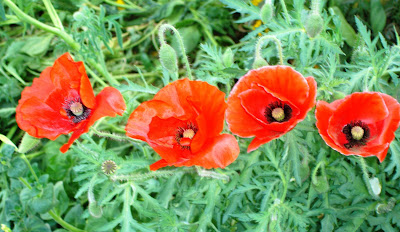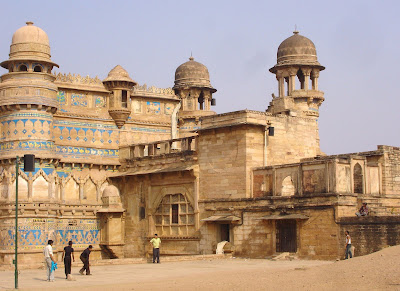Tansen, recognized by many to be the father of Hindustani classical music needs no introduction.
Tansen was born in Gwalior. I went to the Tomb of Tansen to discover there that nearby, there is another tomb of Mohammed Ghaus.

I did not know who was Ghaus was until I made this trip to Gwalior. Now I know more after having returned and read about him online. Someone rightly said, at times, knowledge gained by travelling 100 kms can be more than knowledge gained by reading 100 books.
 Ghaus was a saint of Afghan origin and was the guru (spiritual master) of Akbar and Tansen. The art of his tomb is presumed to be an example of Mughal architecture in its infancy.
Ghaus was a saint of Afghan origin and was the guru (spiritual master) of Akbar and Tansen. The art of his tomb is presumed to be an example of Mughal architecture in its infancy.  Square in construction, there are four burj (towers) on four sides and the structure is surrounded by beautiful jaali (lattice) with a big dome on top that was supposedly decorated once with shining blue stones.
Square in construction, there are four burj (towers) on four sides and the structure is surrounded by beautiful jaali (lattice) with a big dome on top that was supposedly decorated once with shining blue stones.
The Tomb of Tansen, built in the 16th century, is comparatively simple. It is on a rectangular elevated platform with a pillared gallery in the center. There is a legend about a tamarind tree near his tomb that still stands though it has dried up now. Credulous singers used to chew the leaves of the tree to be blessed with sweet voice.
Akbar, being a great patron of arts and music, encouraged it so much that what is now known as Hindustani classical music flourished under his patronage. Tansen, of course, was leading a grand array of accomplished musicians. Would you like to have another look at the picture of Anup Talao (also called the Peerless pool) in my post here (4th picture) where Tansen was known to be seated on the beautiful platform of square red sand stone enclosed by railing with lovely jaali work. Abul Fazl in Akbarnama recorded that this pool used to be filled with gold, copper and silver coins that shimmered in the sunlight. Jehangir has mentioned in his memoirs that he arranged distribution of coins in charity worth one crore three lakh rupees that were emptied out of that pool.
In Indian culture, Tansen continues to remain an enigmatic legend as the most melodious singer and instrumentalist. Almost all gharanas of Hindustani classical music claim some connection with the Tansen lineage.
The garden in which the tomb is located is the locale for the annual music festival called Tansen Samaroh that is held during December each year where notable musicians from across the world and India gather to perform during the festival. That festival got over a day before I reached Gwalior!
While on the topic of music, it would be appropriate to mention here the name of one of my favourite music artist, the Sarod Maestro Ustad Amjad Ali Khan, who was born in Gwalior. (Incidentally, ex-Prime Minister Vajpayee was also born in Gwalior.) Ustad Amjad is recognized throughout India as one of the best classical musicians. He is the torch-bearer of the Gwalior Gharana and is said to be representing the sixth generation of his family to inherit the tradition of classical music. That goes back to the era of the court musicians of the Mughal Empire and the original Senia-Beenkar Gharana musical school devoted to the tradition of the legendary Tansen. What I also admire about him is his visit to Pakistan in 1981. By doing so, he became the first Indian musician to break the "culture silence" between the two countries.

I'll end this post on the Musician Extraordinaire by quoting Pandit Birendra Kishore in his interesting and informative book, Indian Music and Miah Tansen:
"During the epoch of the most glorious period of the Moghul Empire the musical culture of North India rose to the Zenith. Mian Tansen, the greatest disciple of the saint and musical seer, Swami Haridas of Vrindaban, was the central figure around whom a renaissance of Hindusthani music took place. The new features added during this period could never be brushed aside, for in the teaching of Tansen could be found the key that incorporated and federated the musical arts of India and the Middle East through a rhythmic pattern that was however India's own creation. In the past, the spirit of this synthesis had incorporated Greek and Arabian melody types into the Indian scheme. The creation of such a scheme was a triumph for the musical genius of India."

























